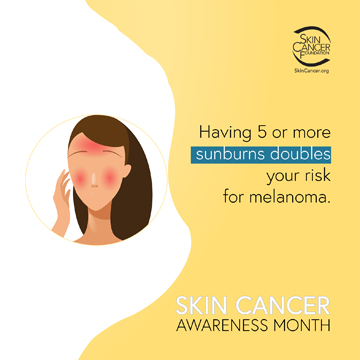What does that mole mean?
May 13, 2022
Sunlight is something we haven’t seen a lot of lately, but certainly, something to look forward to as summer is around the corner. The problem is, that too much of a good thing, can also be a bad thing. Ultraviolet (UV) rays which are emitted from the sun as well as tanning beds, etc are also the number one cause of skin cancer.
May is Skin Cancer Detection and Prevention Month. Every year in the United States, five million new cases of skin cancer are diagnosed. Skin cancer is America’s most common cancer. The good news is, that it’s also one of the most preventable cancers. The best thing you can do to prevent skin cancer is to wear your sunscreen, avoid direct sunlight, and cover up with clothing when outdoors.
There are three main types of skin cancer. Basal cell carcinoma (BCC) is the most common form of skin cancer, accounting for over 70% of skin cancer diagnoses. BCCs are uncontrolled growths that can appear as open sores, scars, shiny bumps, or red patches. BCC’s are also the least dangerous of skin cancers, although if not caught early they can be locally destructive causing significant scarring or disfigurement.
The second most common form of skin cancer and slightly more serious is squamous cell carcinoma (SCC). This type of skin cancer can present as scaly red patches, warts, or open sores. These sores may crust or bleed. SCCs mainly occur due to cumulative UV radiation exposure throughout a lifetime.
Lastly, melanoma is the least common form of skin cancer, but also the most dangerous. Melanoma occurs slightly more often in men. Risk factors for melanoma include family history, exposure to UV radiation, skin pigment (lighter skin is more at risk), living close to the equator/or at a high elevation, having many moles/unusual moles, or a weakened immune system. History of severe sunburn is a factor too. On average, a person’s risk for melanoma doubles if they have had more than five sunburns.
Regular self-exams are essential in recognizing new or changing moles or skin irritations. Follow your ABCDE’s when doing your self-exam.
- A for Asymmetry: Half of the mole or mark doesn’t match the other half.
- B for Border: Irregular, jagged, blurry, or notched edges.
- C for Color: Non-uniform color that includes different shades of black or brown or red, white, pink, or blue patches.
- D for Diameter: The growth is more than ¼ inch in diameter (about the size of a pencil eraser.)
- E for Evolving: The mole is growing or changing color or shape.
The key is being familiar with your body, and recognizing any changes. When it doubt, get it checked out. If you are concerned about a spot on your skin, schedule an appointment to see your medical provider at Mille Lacs Health System. Call 320-532-3154.
